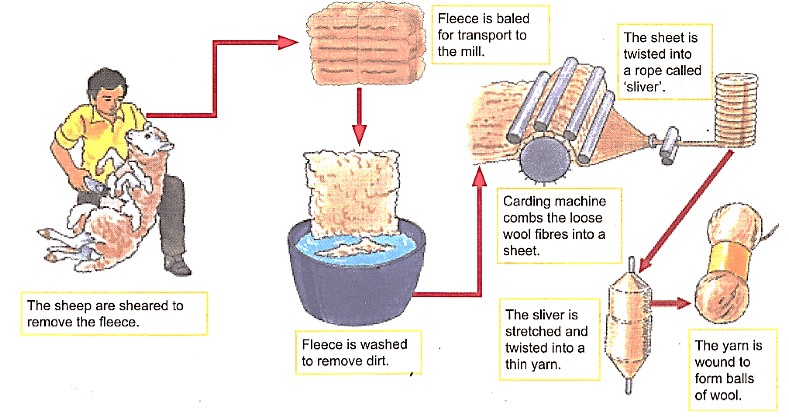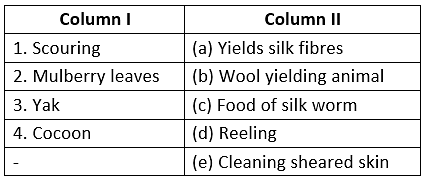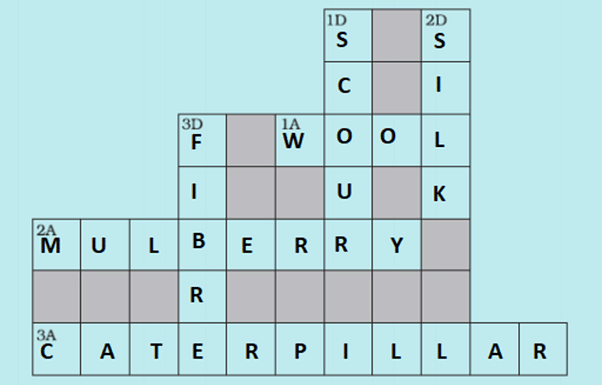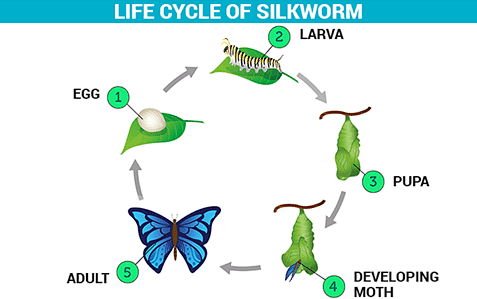NCERT Solutions for Class 8 Science - Fibre to Fabric
Excercise
Q1. You must be familiar with the following nursery rhymes:
(i) ‘Baa baa black sheep, have you any wool.’
(ii) ‘Mary had a little lamb, whose fleece was white as snow.’
Answer the following:
(a) Which parts of the black sheep have wool?
(b) What is meant by the white fleece of the lamb?
Ans: (a) The hairy skin i.e. fleece of the black sheep has wool.
(b) White fleece means the white coloured hair of the lamb. The complete process from fleece from sheep to yarn of wool
The complete process from fleece from sheep to yarn of wool
Q2. The silkworm is (a) a caterpillar, (b) a larva.
Choose the correct option.
(i) a
(ii) b
(iii) both a and b
(iv) neither a nor b
Ans: Correct Answer is Option (iii)
Q3. Which of the following does not yield wool?
(i) Yak
(ii) Camel
(iii) Goat
(iv) Woolly dog
Ans: Correct Answer is Option (iv)
Q4. What is meant by the following terms?
(i) Rearing
Ans: Rearing: It means taking care of herds of animals which includes feeding, grazing, breeding, etc. for economical purposes like meat and other useful products.
(ii) Shearing
Ans: Shearing: The removal of the fleece of the sheep along with a thin layer of skin from its body is called shearing.
(iii) Sericulture
Ans: Sericulture: The rearing of silkworms to obtain silk economically is called sericulture.
Q5. Given below is a sequence of steps in the processing of wool. Which are the missing steps? Add them.
Shearing, __________, sorting, __________, __________, _________.
Ans: Shearing, scouring, sorting, burrs picking, dying, rolling
Q6. Make sketches of the two stages in the life history of the silk moth which are directly related to the production of silk.
Ans: The two stages in the life history of the silk moth which are directly related to the production of silk:
- The spinning of the cocoon of silk threads around the caterpillar.

- Changing the caterpillar into a pupa.
Q7. Out of the following, which are the two terms related to silk production?
- Sericulture
- Floriculture
- Moriculture
- Apiculture
- Silviculture
Hints:
(i) Silk production involves the cultivation of mulberry leaves and rearing silkworms.
(ii) Scientific name of mulberry is Morus alba.
Ans: Sericulture and moriculture
Q8. Match the words of Column I with those given in Column II:
Ans:
Q9. Given below is a crossword puzzle based on this lesson. Use hints to fill in the blank spaces with letters that complete the words.
Down:
1D: Thorough washing
2D: Animal fibre
3D: Long thread-like structure
Across:
1A: Keeps warm
2A: Its leaves are eaten by silkworms
3A: Hatches from the egg of a moth
Ans:

|
26 videos|32 docs|9 tests
|
FAQs on NCERT Solutions for Class 8 Science - Fibre to Fabric
| 1. What is fibre in the context of textiles and fabrics? |  |
| 2. What is the process of spinning in the production of textiles? |  |
| 3. What is the difference between weaving and knitting? |  |
| 4. How is dyeing of textiles done? |  |
| 5. What is the importance of quality control in textile production? |  |
|
26 videos|32 docs|9 tests
|

|
Explore Courses for Class 6 exam
|

|



















